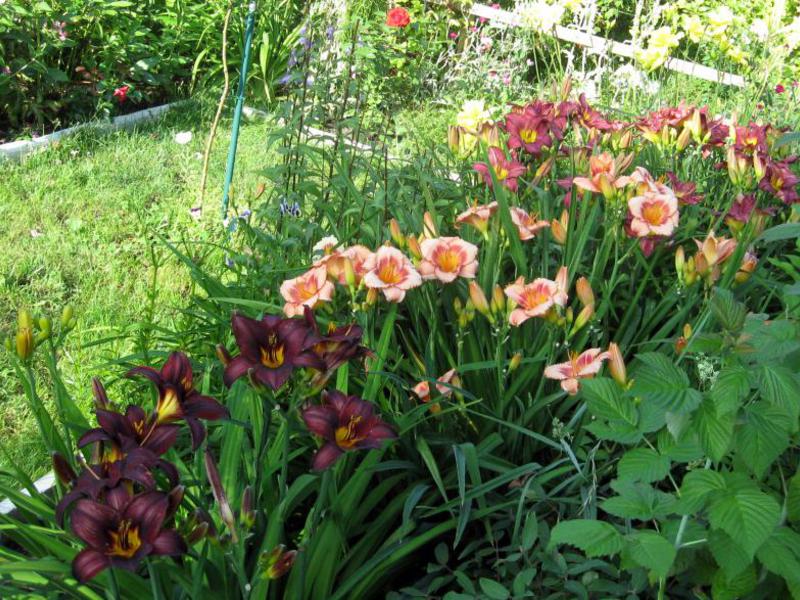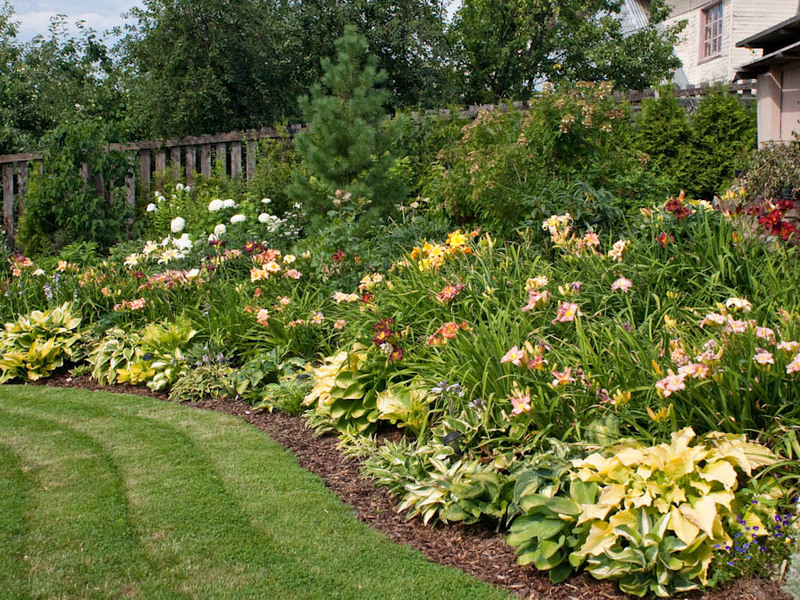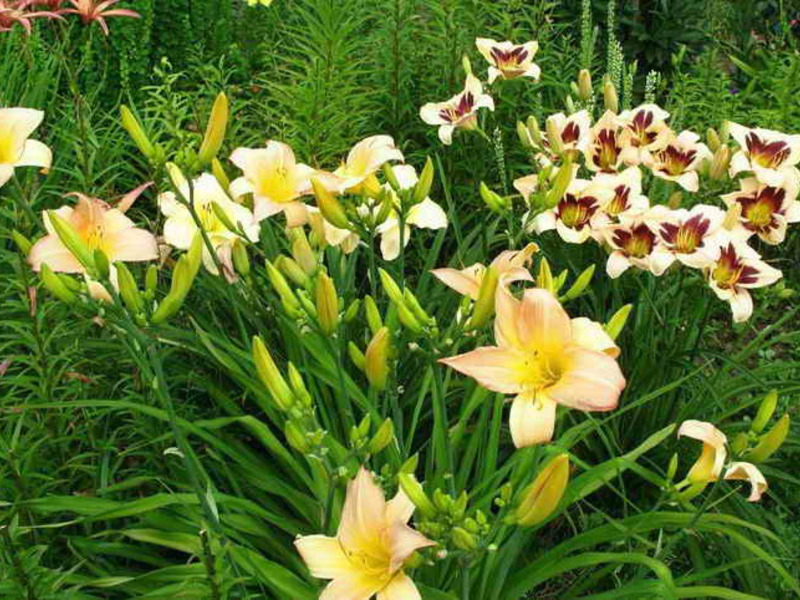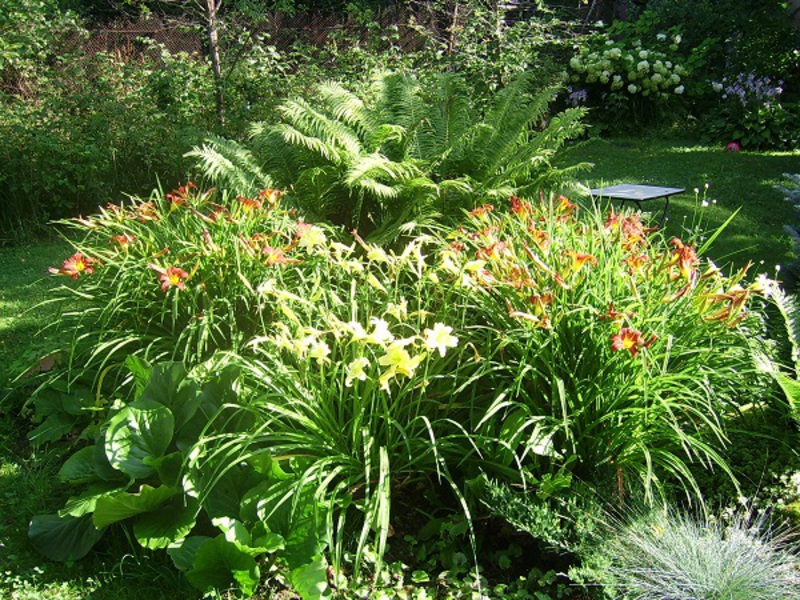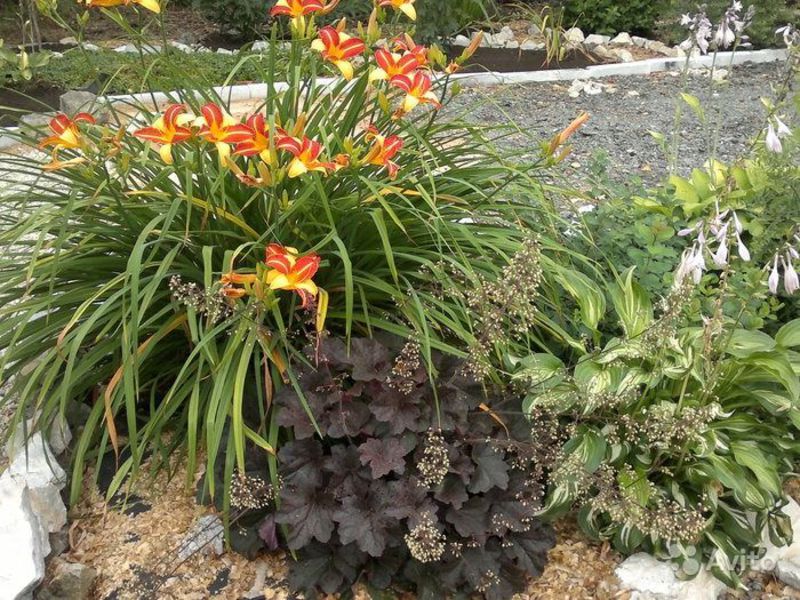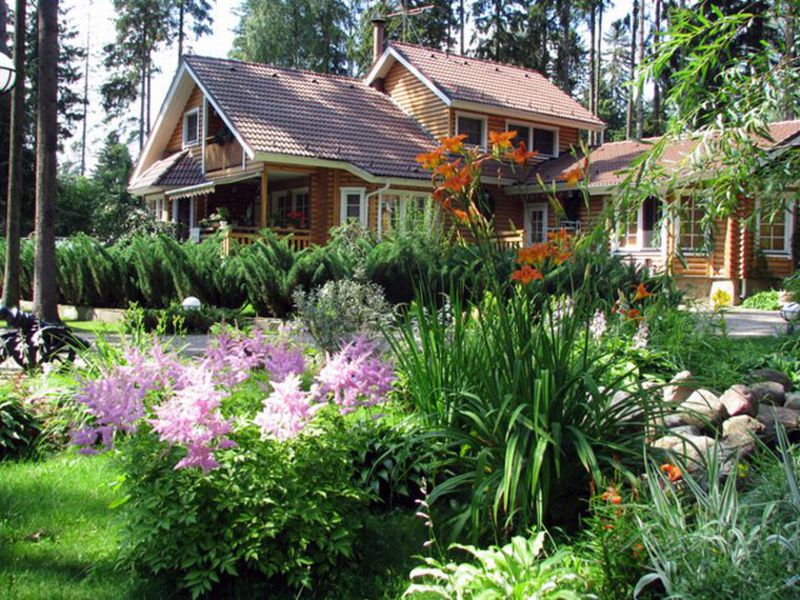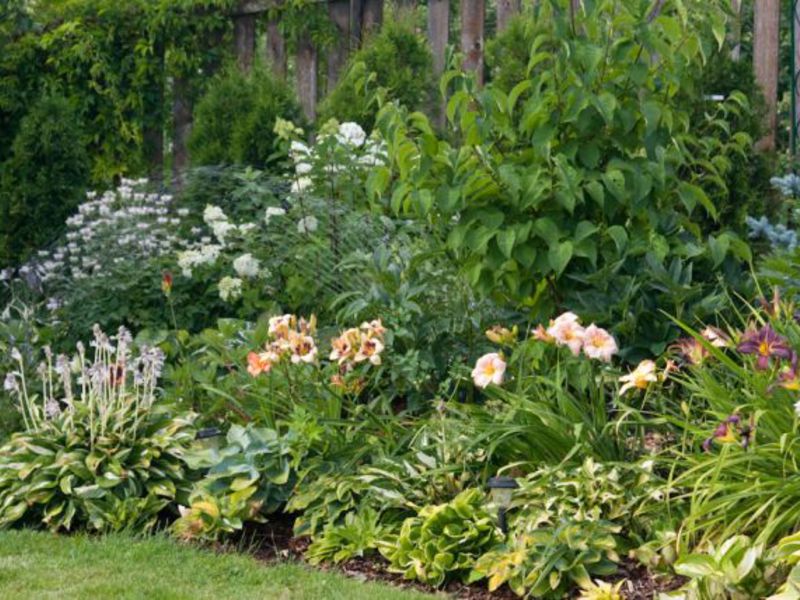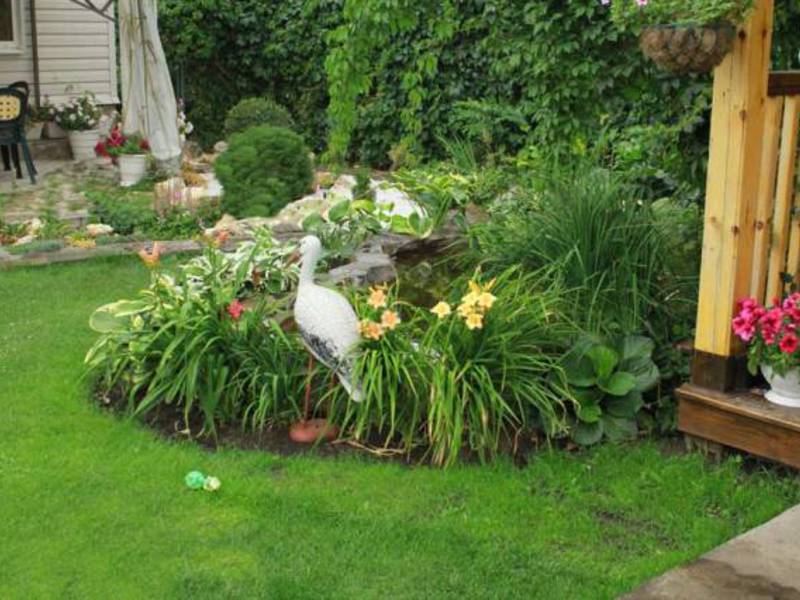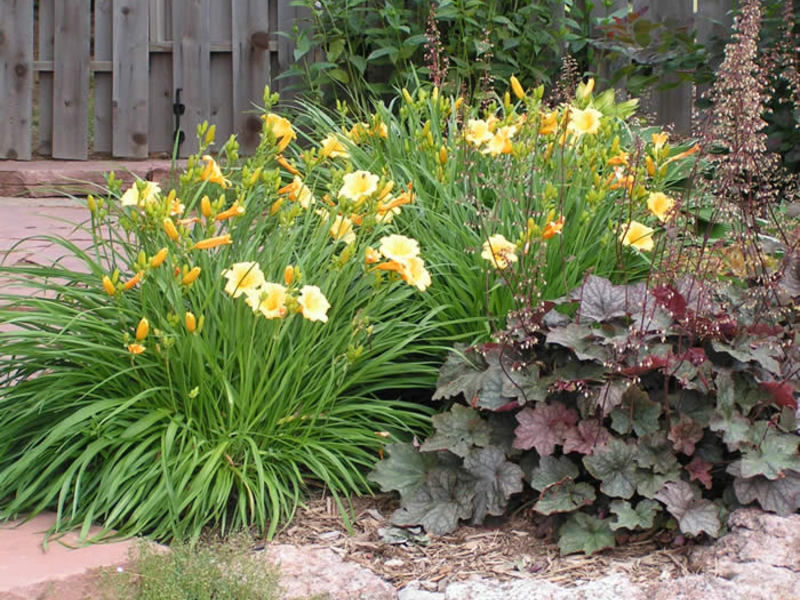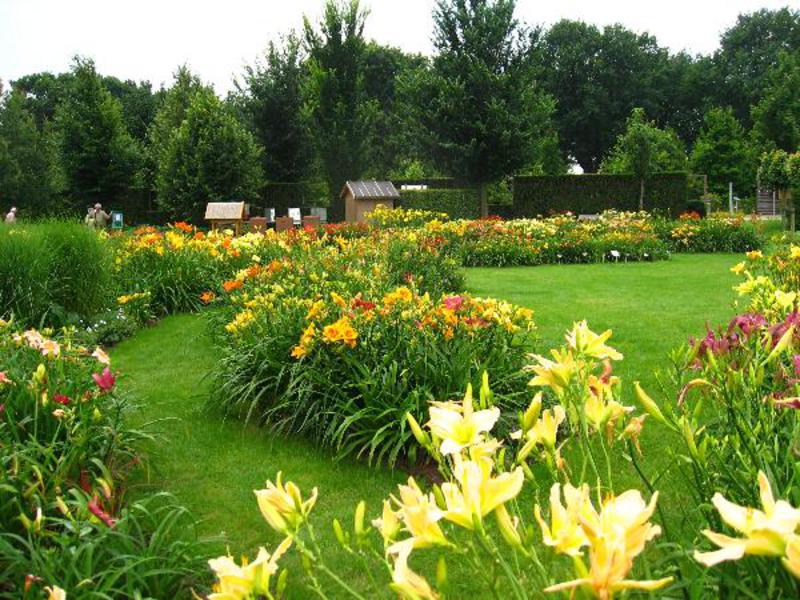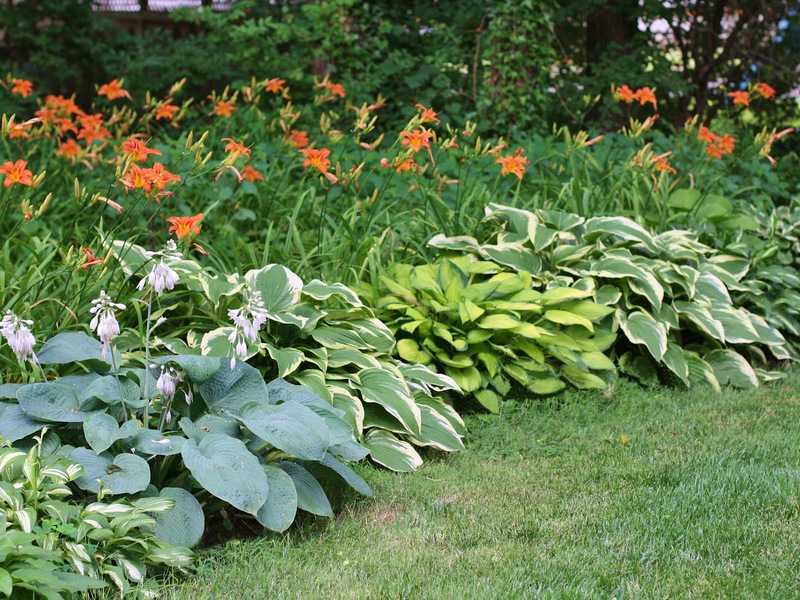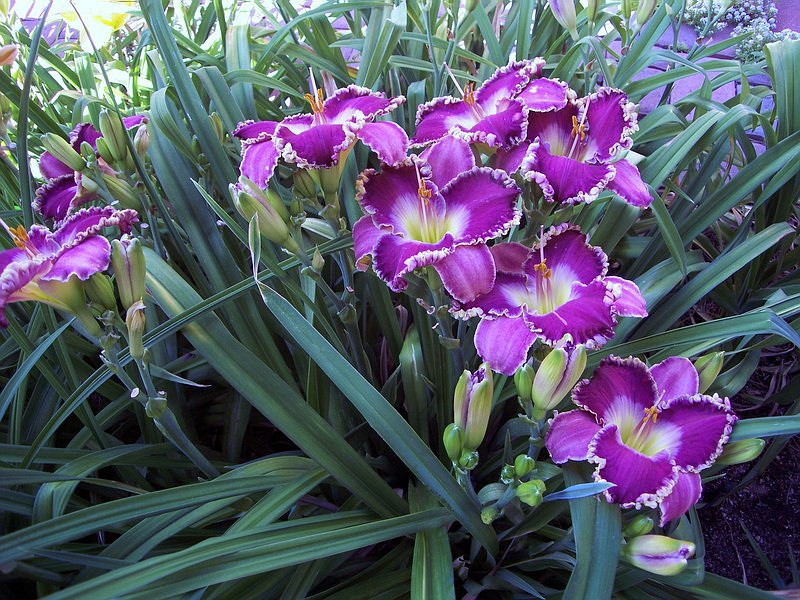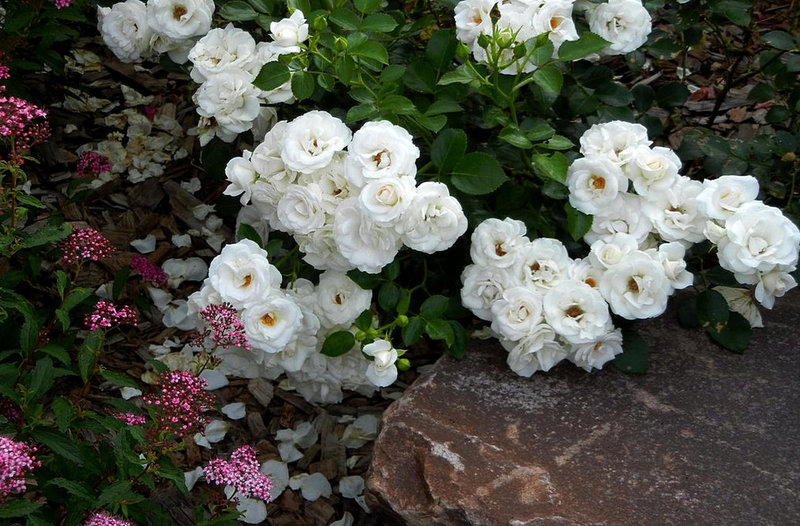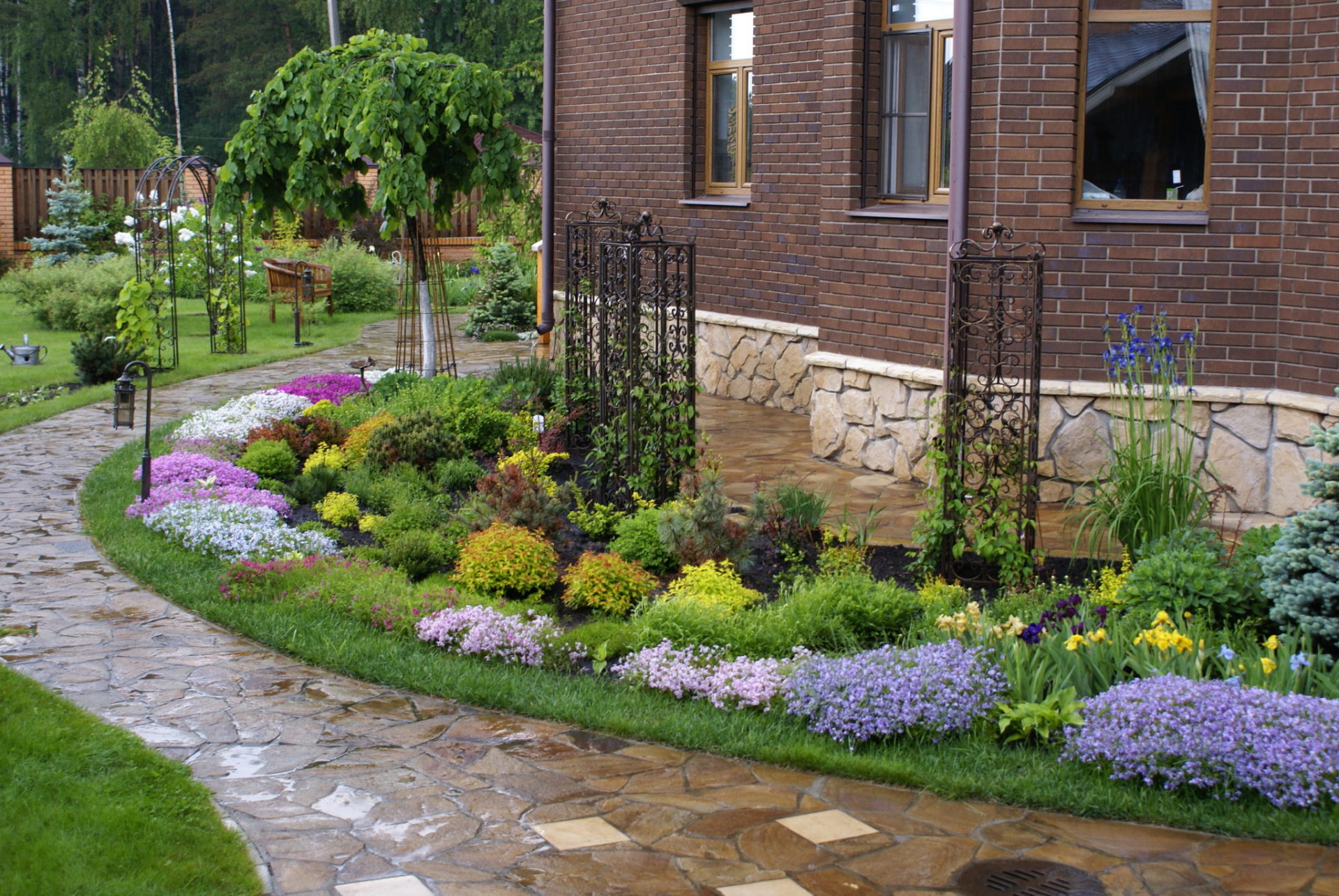Landscaping of the backyard area is an amazing opportunity to make a "heavenly place" on the site of your house, in which the air will be filled with the smells of beautiful flowers, and their bright compositions can delight the eye. There are many ways of landscaping: you can plant both exotic and rare types of flowers, shrubs, trees, as well as the species familiar to your area - it depends on the capabilities and preferences of the owner of the site.
Content
Daylilies in landscape design: types and photos
Daylilies are one of the few perennial flowers that will be an ideal solution for landscaping a backyard area due to their attractive appearance and ease of maintenance. A long flowering period, decorative leaves, a wide range of colors, shade tolerance and ease of cultivation are the main advantages of this flower. Daylilies are quite simple to combine with the rest of the shrubs and flowers, they will certainly adorn any composition. But before planting the garden, there are some points to consider:
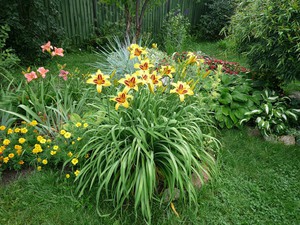 Selection of daylilies by color with the rest of the plants.
Selection of daylilies by color with the rest of the plants.- Will daylilies be the main accent in the composition or will it be isolated plantings of single flowers.
- How daylilies will look like when planted near a house, fence or utility structures, if they need to be decorated.
- The choice of a variety of simultaneous or different flowering times.
Varieties of daylilies
For the varieties of daylilies described below, you can make a choice of flowers for garden landscaping.
Middendorf
This low compact plant up to 65 cm "wakes up" one of the very first. The bush begins to bloom at the end of spring. Long and narrow leaves are slightly bent to the sides. The buds are bright with a yellow-golden color with a delicate scent.
Brown yellow
It is the most widespread and popular variety. A large plant, over one meter in size with red-orange flowers and voluminous rich green leaves. It tolerates shading well and begins flowering in the month of July. For a long time, many gardeners have known its terry Kwanso and Flore Pleno varieties.
Yellow daylily
A tall plant, about one meter in size with fragrant inflorescences that begin to bloom from July to the end of August. The bush can tolerate highly humid areas and therefore it is planted near home ponds.
Daylily lemon yellow
This drought-resistant plant blooms profusely in the month of July. The inflorescences of this bush are fragrant with a pleasant smell, and its tall peduncles up to 120 cm rise above all the leaves.
Hemerocallis - the Latin name for daylilies, came from several words, hemera - which means "day" and kallos - translated as "beauty". This means that one flower, per inflorescence, can bloom for only one day.
Arrangement of daylilies on a personal plot
When placing daylilies in the garden, you need know some rules:
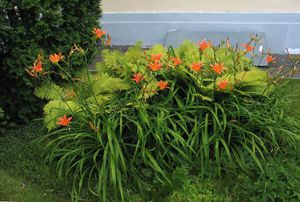 Low-growing daylily species in the garden, such as Eenie Winnie and Longfild Glory, are used to decorate the design of alpine slides.
Low-growing daylily species in the garden, such as Eenie Winnie and Longfild Glory, are used to decorate the design of alpine slides.- Aromatic and fragrant varieties are grown near the benches, which include the species - Siloam Double Classic. These varieties of plants are not inferior in attractiveness to roses, but caring for them is much easier and they do not have thorns.
- Daylilies of the same type are planted near the walls. These varieties must be contrasting colored or of the same color. For example, flowers with a large eye are possible. These species include Outrageous, Galaxie Barogue and Always Prestnt. Or a tall view is planted near the wall itself, and a lower one is placed in front of it with flowers of a different shape or size, but with the same color. For example, a small daylily Siloam Doodleboud and a larger Always Present are possible.
- Large-flowered and tall varieties with contrasting eyes are planted among the bushes. The front row of this composition is planted with hosts with beautiful foliage. To make the effect stronger, a red-leaved barberry must be planted near the flower bed.
- Daylilies, planted near the winding path, look attractive. On one side of the path in the background, daylilies with large flowers are planted, and in front of them are more compact. And on the other side of the path, you can plant tall buzulniks and astilbe. They are in perfect harmony with daylilies in shape and color.
- Against the background of a house or buildings painted in a dark color or built of red brick, daylilies of yellow flowers look great. On the other hand, daylilies of dark or bright colors - violet, reds and purples - are best suited to the design of a light facade.
Low-growing flowers for a flower bed in the country, blooming all summer:https://flowers.desigusxpro.com/en/sadovye-cvety/nizkoroslye-cvety-dlya-klumby-na-dache-cvetuschie-vse-leto.html
Combining daylilies with other flowers
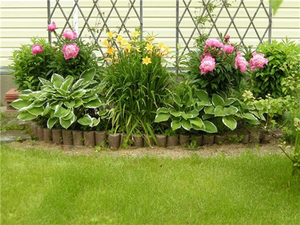 Daylilies with star-shaped or round flowers are best combined with the same inflorescences of other flowers spherical or pyramidal... Also, when choosing daylilies, you need to pay attention to the color of the middle of the inflorescence. It, regardless of the color of other petals, can be green-yellow, yellow, olive green, green, orange.
Daylilies with star-shaped or round flowers are best combined with the same inflorescences of other flowers spherical or pyramidal... Also, when choosing daylilies, you need to pay attention to the color of the middle of the inflorescence. It, regardless of the color of other petals, can be green-yellow, yellow, olive green, green, orange.
If the plant has a green center of the flower, then it is easier to fit into different contrasting compositions, since the green shade is the main background of the foliage. And if you have daylilies with a yellow center in your garden, then they must be carefully combined with the rest of the plants in color. For example, yellow-leaved canvases are perfect for this type of daylily. You can also choose neighboring plants that are in harmony not only in color, but also in shape. For example, you can plant evening primrose.
It is especially necessary to carefully choose neighboring plants for daylilies of red shades. They should be planted in places where there are many yellow flowers, since this color suppresses all the brightness and purity of the red color.
You can arrange compositions in which there will be flowers of the same shade, combining daylilies apricot, orange or yellow with buzulniks and gravilats of the same shades. And varieties of raspberry, pink and lilac plants will perfectly combine with monards, geraniums and astilbe. To accent the dominant color, you can add a little contrasting colors. For example, dilute golden or orange with blue, add menocopsis or bells to a purple flower, and a green-yellow cuff to pink.
Flower beds on which daylilies of different patterns and the same tone are combined will look attractive. For example, you can combine three different types with the same shape of inflorescences: 2 of them can be purple in two shades, the petals of which are darker inside the outside. These types include Pony and Prairie Blue Eyes. And the third type is rich lilac with a butterfly eye in a rich lilac color - Mokan Butterfly.
Astilba is appreciated by both professional gardeners and amateurs for its unpretentiousness, as well as lush and long flowering:https://flowers.desigusxpro.com/en/sadovye-cvety/posadka-astilby-i-uhod-v-otkrytom-grunte-instrukciya-i-foto.html
Combining daylilies with phlox
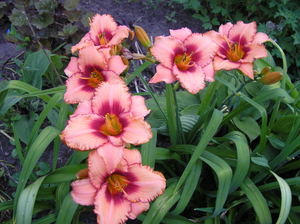 Active flowering of phlox, just like daylilies, takes place in the month of July. Due to their similarity in color and different shape of the buds, you can create original compositions... The pattern of daylilies with silvery eyes will repeat quite nicely in small phlox flowers.
Active flowering of phlox, just like daylilies, takes place in the month of July. Due to their similarity in color and different shape of the buds, you can create original compositions... The pattern of daylilies with silvery eyes will repeat quite nicely in small phlox flowers.
This can be seen in the example when Elizabeth Anne Hudson's purple daylily with a silver eye is combined with the Lilac Caprice phlox, in the middle of which is a dark purple ring. And purple-blue daylilies with bright eyes of Malaysian Monarch will perfectly harmonize with the non-fading deep purple phlox Ametist.
Or you can make a combination of the same daylilies and lilac or lilac phlox, which have a light middle. You can also create a beautiful combination of white or bright pink phlox with carmine eyes, for example, Delta, Europe, Alyonushka with daylilies, which have the same color Pandora Box, Brilliant Circle, Janice Brown.
Accommodation design from some daylilies
On the backyard or in the garden, you can make plantings from only one plant. In this case methods of contrast and harmony are applied:
- When planting harmonious compositions, a combination of plantings of delicately colored plant species is used, which have different shade intensities, but the same color scheme. For example, it can be a combination of apricot, pink and yellow. Moreover, the lightest species is chosen as the dominant one, and taking into account the distance, the intensity increases.
- When organizing a contrasting flower bed, you should not mix different colors. In this case, daylilies of the same tone are used, organizing large monochrome spots from them. For example, you can combine magenta with yellow-gold.
New varieties of daylilies are quite diverse in shape and color. And so that the garden does not look like some kind of patchwork blanket or vinaigrette, you need to be very careful about the choice of plants.
Daylily selection by leaves
At that time, while the inflorescences of daylilies have not yet begun to bloom or, conversely, have already faded, their leaves also play a role in garden landscaping. Leaves can be deep green with a bluish tint, green-olive and green-yellow. Leaves also vary in size. They can be rather narrow, like in cereals, or wide, falling beautifully downward, or, conversely, directed upward and only slightly deflected.
They are similar in size, texture or shape to the leaves of geraniums, peonies, delphiniums, bells, phlox. If the backyard is shady, then digitalis, hosts, volzhanks will look great near the leaves of daylilies, ferns, peltiphyllum, reed grass.
Storing daylilies before planting
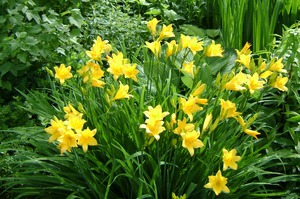 When purchasing daylilies in the spring, you need to provide them with proper safety before landing in the ground... If the buds on the roots have not yet "woken up", then you can store the plants in the refrigerator, checking them from time to time. And the flowers that have already woken up are planted in pots, setting them on the windowsill on the south side. It is necessary to water the plants as the earth dries up. There should not be an excess of moisture, otherwise the roots will begin to rot and it will be impossible to save the flowers.
When purchasing daylilies in the spring, you need to provide them with proper safety before landing in the ground... If the buds on the roots have not yet "woken up", then you can store the plants in the refrigerator, checking them from time to time. And the flowers that have already woken up are planted in pots, setting them on the windowsill on the south side. It is necessary to water the plants as the earth dries up. There should not be an excess of moisture, otherwise the roots will begin to rot and it will be impossible to save the flowers.
Most often, daylily plantings are mixed with hosts. Read more about this amazing plant in our material:https://flowers.desigusxpro.com/en/sadovye-rasteniya/hosta-posadka-i-uhod-v-otkrytom-grunte-vidy-i-foto.html
Reproduction of daylilies
Plants are propagated by seeds or by division. In the latter case, it is advisable to do this at the end of summer. This is the easiest time find all points of growth and the flowers will have time to take root.
During division, daylilies must be removed from the ground and cleaned of soil.For less deformation of the root system, it is cut with a sharp blade from above.
In order to multiply the plant faster, during division, one bud and at least one root must be left on each part. If the transplant takes place in the summer, then the leaves must be cut to 4 cm in order to reduce moisture evaporation.
Correct planting of daylilies
To make plants look attractive in the garden, they it is necessary to land correctly:
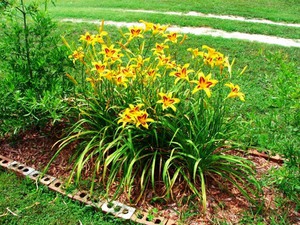 Daylilies should be planted to a depth of about 6 cm, but in no case should the plant be buried. Because with deep planting, the bushes will look depressing and bloom weakly. The leaves will die off and turn yellow. But shallow planting is also harmful, in this case, daylilies can die in the winter.
Daylilies should be planted to a depth of about 6 cm, but in no case should the plant be buried. Because with deep planting, the bushes will look depressing and bloom weakly. The leaves will die off and turn yellow. But shallow planting is also harmful, in this case, daylilies can die in the winter.- The soil must be slightly moist, loose, rich in nutrients and organic matter.
- The land under the daylilies should be mulched with stale sawdust, fallen pine needles or humus.
- It is better to feed the plant in spring and at the very beginning of summer. But carefully add nitrogen. With its excessive amount, foliage will strongly germinate at the expense of flowers.
Today, daylilies are widely used in garden design due to their good growth, unpretentiousness, and also long and beautiful flowering... There are few cultures that have so many virtues.
